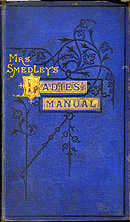|
|
  Caroline Smedley |
||||||||||
Twenty years or so earlier Adam provided a description of this scene. "The road, ... following the course of the stream till nearly reaching the Hat Manufactory, almost hidden by the thick wood, where it turns northward, leaving the beautiful and more open Valley of the Derwent, and passes up the narrow but richly wooded mountain brake in which the hamlet of Lea is situated. A little above this is another Manufactory for Hosiery and Merino Spinning, belonging to Mr. Smedley, whose house is close by ; and but a short distance beyond, higher up the Dale, is the "cupola", or Lea Smelting Mills, belonging to Mr. Wass and Son" [2]. In a footnote the Smelting Mills are described as being similar to those in Bonsall Hollow. Both Peter Davies in 1811[3] and Stephen Glover in 1829[4] discuss the hat making industry at Lea-wood and it is from Glover that we learn that the government had, for many years, contracted for soldiers' military caps, helmets, etc.. The mill described by White and Adam is still operating today but it was a close-run thing for a time in the 1820s. In 1818 the Smedley family's hosiery business transferred to Lea Mills from Wirksworth, where the John Smedley we most associate with the company had been born on 12 June 1803. The youthful John Smedley had left school in 1817 and was helping his father, also called John, in the family firm[5]. It was not successful in the new location and is said to have twice been on the verge of bankruptcy[6]. Following the death of John and Mary Smedley's younger son, George, who died in December 1827, John Smedley senior virtually abandoned the business. It was left to the younger John to rescue it, although he had been saddled with heavy liabilities. He was to prove to be a hands-on employer, in the Mill before his employees arrived and often there after they had gone. He adapted the machinery from cotton spinning to wool manufacture and, unlike many others, he was good to his workforce so there were no strikes at Lea Mills whilst he was running the business. As du Garde Peach put it "he showed a "singleness of purpose which enabled him later to carry through his great experiment in healing"[6]. His father died in 1840[7], by which time the younger Smedley's new processes were a success. He did not marry until 1847[8]. After his own experience of the hydropathic "cure" he began to taken a few invalid workmen into his home at Lea Bridge. He cared for his workforce in other ways, too. He provided a cook house, with servants who prepared wholesome food. There were galoshes and waterproof capes for female workers and sleeping quarters were available for those who lived at a distance when the weather was bad. He also gave his employees half an hour for religious worship and for hearing about important events going on in the world[9].
|
|||||||||||
The above 19th century engraving has been taken from: Smedley, Mrs. (1878/9) "Ladies' Manual of Practical Hydropathy (Not the Cold Water System), 16th ed.", James Blackwood & Co., Lovell's Court, Paternoster Row, London. By the time this edition was published Mr. John Smedley, Mrs. Smedley's husband, had been dead for some years and the business had been taken over by Smedley's Hydropathic Company (Limited) Caroline Anne Smedley wrote in her preface: "After reading many works on hydropathy in conjunction with my husband, I consider that they are written too scientifically for Ladies who have not studied Medical and Anatomical Works, and who are therefore ignorant of the many terms made use of only in such works, and which are not at all necessary to be known by the generalities of our sex in the ordinary duties of life. This little Manual will therefore be entirely free from such terms ... " This book is in the collection of, the information is provided by and images scanned by and © Ann Andrews. Intended for personal use only The engraving was also published in Smedley's "Practical Hydropathy". |
|||||||||||
|
[1] General Commercial Directory and Topography of the Borough of Sheffield with all the Towns, Parishes, Villages and Hamlets Within a Circuit of Twenty Miles, pub. Francis White & Co. Sheffield (1862). Smedley advertised on p.601 - Smedley John, merino spinner, and hosiery manufacturer, Lea Mills. [2] Adam, W. (1840) "The Gem of the Peak" London; Longman & Co., Paternoster Row. Also "The Derby Mercury", 13 May 1835, tells us that the firm traded as John Alsop & Co. but Joseph Wass had been in partnership with the Alsops until they died. [3] Davies, David Peter (1811) "History of Derbyshire" pub. S. Mason, Belper. See extracts Parishes I - O in another part of this web site. [4] Glover, Stephen (1827-8-9), "Directory of the County of Derby", introduction. [5] Bryan, Benjamin (1903) "History of Matlock - Matlock, Manor and Parish" London by Bemrose & Sons, Limited. [6] Peach, Lawrence du Garde (1954) "John Smedley of Matlock and his Hydro", Bemrose Publicity Co.: Derby & London [7] "Derbyshire Courier", 14 March 1840."At Lea Bridge on the 5th instant, Mr. John Smedley, aged 75, angola manufacturer, much respected". [8] He married Caroline Ann Harwood on 24 June 1847 by licence. She was the daughter of the Reverend John Harward, M.A., incumbent of Middleton sic ("Leicester Journal And Midland Counties General Advertiser", 2 Jul 1847. He was vicar of Wirksworth in 1851, where he had been since 1831. Caroline was born at Frome, SOM where her father was Curate, on 12 Mar 1822. She passed away at Riber on 26 February 1892. [9] From "John Smedley, Millowner, Hydropathist and Philanthropist" a
booklet reprinted from and article that appeared in the Derbyshire Countryside. No date. Jane Leslie collection. |








 Lea Mills is mentioned in
Lea Mills is mentioned in